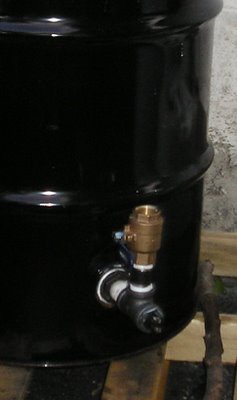Thursday, June 29
Oil Pickup
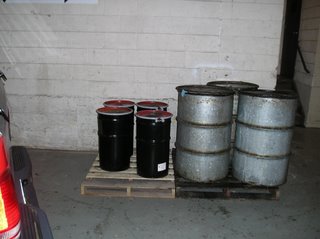

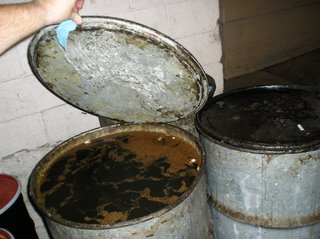
Several folks have asked me about my oil source. Fortunately for me, I got a brainstorm one day at my job, and walked down to the company cafeteria. My timing was perfect, as they are very upset with the local renderer who they'd contracted to pickup their grease. This renderer, who shall go anonymously by the name "Outland", wouldn't come when called, and had been leaving them with multiple barrels full of goo. You can see this in the grey barrels in the pictures. The same grease has been awaiting pickup by "Outland" for 3 months, just sitting and stinking. After explaining a bit what I wanted to do, and determining their needs and points of pain, I came up with a solution to pick them up in 10-gallon mini drums.
This couldn't be much easier. I stop by after lunch each day, rock the mini-drums to see how full they are, and keep tabs on when I need to make a pickup. Not only does this keep my costs low and ensure good service, but it also makes my daily commute completely tax deductible as a business expense for servicing my oil route.
The black drums are mine, and the grey nasty ones belong to the, erm, "Outland" renderer who isn't picking up their crap.
Dewatering fabrication
I'm working on fabrication to solve the dewatering problem, which I've addressed in two ways, since there are actually two dewatering problems to solve - suspended (dissolved) water and separated water.
First, I need to get the suspended water out of the oil. After filtering out the food bits, there can be a substantial amount of water suspended in the oil, which is "dissolved". I've read several accounts on various Internet forums that point to rock salt as the common method for dewatering oil and diesel fuel, and rock salt appears to be a standard solution by the petroleum industry and fuel distributors for dewatering diesel. Apparently, salt will not bond with oil or fuel, but the water bonds to the salt, and becomes heavy, as brine, and sinks to the bottom. This will give me a layer of brine below the oil. I plan on achieving this by adding a good 4-6 inches of rock salt in the bottom of my filtering unit, above a filter I'll need to thread in. So, the oil will drip from the sock filter through
the salt bed, which should bond to any water, and give me a good layer of separation. When I pour off the oil, it should be easy (??) to not pour the brine into the 55-gallon drum.
However, there will doubtless be some water in the drum. In fact, I think there's about a gallon in there now, from the prior batch of watery oil I filtered direct into the drum. This will have suspended water in it, but at least it's only a minimal amount, and my brute-force method for final dewatering should solve it. The drum I'm using has a bottom bung, which is about 5" from the bottom on the side of the drum. I've installed a 2"-to-1" bushing, 1" x 4" nipple, and a 1" tee. Coming up from the tee is a 1" brass ball valve, and straight
out from the tee is a 3500 watt heating element designed for a water heater, which is threaded in and sticking about 12" into the drum.
It's not touching the fittings, and is largely inside the drum. I plan on using this to heat the oil in the drum sufficiently to boil off the water into steam, and have an auto temperature gauge to
install in the drum, if I can just figure out how to install it. I think I can drill a hole in the drum and screw it in with a nut and O-ring inside the drum, and O-ring outside the drum, provided it's an O-ring that can take the heat.
I think the best way to manage the steam will be to screw a nipple into the 3/4" fitting in the lid of the open drum, put an elbow on it that will take it 5" over to the side of the drum, then to a T that is pointing up and down. I'll put a 2' pipe going down from the T, with a bucket below to catch water dripping, and put a 3' pipe going up for the steam vent, so the steam doesn't hit someone.
I'm wondering if I'll also need a coil below, to condense the steam, and keep it from causing burns?? Decisions, decisions. I guess this is why it's called "fabrication" instead of building from a kit. Imagination, creativity, risk and experimentation are all part of the mix.
Oil filtering fabrication
I think I've overcome two issues with oil filtering, which are:
1) How to pour oil 8' off the ground from an 90 pound drum, and
2) Dewatering the oil
First the height/weight issue. No, not mine, though I have the
healthy weight of someone a mere 1 foot taller. I'm talking about my
contraption that has me pouring oil 8' off the ground. I modified the
lid to a 5 gallon bucket last night, and glued a 2" female endcap
fitting to the top of it, so that I can thread my filtering
contraption onto it. (Said filtering contraption being a 3' length of
6" PVC that is necked down through a 6-to-4 slip bushing, into a
4--to-2 slip bushing, which is fitted with a 2" male fitting. At the
top of the 6' pipe, I put a 30 micron sock filter over the top of the
pipe, and use a clamp to secure it. Thanks to Mark Mitchell, the sock
filters are very cheap -- a jeans leg cut off at the crotch and sown
across the bottom, works great. The 2" male fitting at the bottom of
my filter lets me screw this into the top of the fitting I've glued
into the top of the 5 gallon bucket lid, or into a steel drum. This
should let me filter oil by lifting the drums only 4' off the ground,
which is far more manageable. If that is still too difficult to
achieve, I'm thinking about using a shop vac to pressurize a drum and
push the oil out, though I suspect there isn't enough horsepower in a
shop vac.
That's enough for this post... I'll cover dewatering later. In fact,
in the next post.
Monday, June 26
Oil processing tank setup
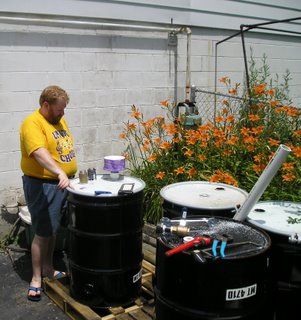
After a significant amount of fabrication guesswork, judicious
wrenching, and multiple trips to Home Depot and Loews, I was finally able to start processing used fryer oil (step 1 in making biodiesel). Now kiddies, don't try this at home, because your mama would slap you (and it would be called justifiable). This is a messy, gloppy, smelly process that includes getting used glop from very dirty fryers, by scraping the accumulated/settled stuff from the bottom of my mini-drums. However, since I can actually reach the bottom of a 10-gallon drum, and can't reach the bottom of a 55-gallon drum, I wouldn't want to think of how messy THAT is. It's not actually that repugnant, since it's like greasy, stinky wet sand, so it does handle easily. However, little bits of greasy breading tend to get on your clothes, arm and the ground surrounding the operation. The dark stuff in the carboy next to the drum is the gunk from two mini-drums, painfully extracted 1/2 cup at a time. Ick.
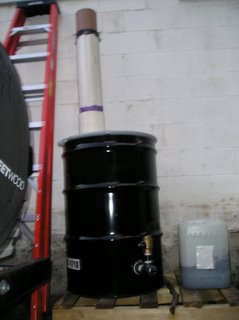
Something I hadn't counted on when preparing to filter used fryer oil is just how difficult it is to lift an 80 pound container up a ladder to a height of 8', and then carefully tilt and pour while not resting on the filtering rim (which can't take the weight). I think I might need to revise my process, though I don't want to spend any more at this point -- I'm already over budget, and the thought of buying a compressor or waste pump at $100 isn't sitting too well. I guess at this point I need to find someone that has a compressor they rarely use, and would let me store it in my garage and use it. Then again, that would also mean buying fitting and hose, as well as a bit more fabrication, welding and the like. Hmmmm... this is a much more involved process than the blogs and books would leave you to believe.
I've noticed a universal lack of details in how to actually process waste vegetable oil with tactical instructions. Sure, there are several threads that talk about sucking used oil behind restaurants into your mobile tank and sucking said glop back into drums in your processing center, but I've not found methods that treat the issue of managing the used fryer oil without investing in mobile tanks and significant pumps. Oh, yes, also investing in a truck. In the interim, I'll probably dump from the mini-drums into a 5-gallon bucket, which I can use to pour the oily goo while standing on the ladder, and will continue to rely on friends to help me get the oil from downtown to my driveway (which is less than optimal).
The issue of filtering and dewatering used fryer oil is where I hope the MidOhio Biofuel Co-op can help, by providing some facility and resources so I can contribute oil and get out filtered oil in 5-gallon carboys that are actually manageable.
Tuesday, June 13
Crystal meth & biodiesel

Some of my friends at work have jokingly made comments about the lab I'm setting up for titration of biodiesel, and call it the meth lab. Well, tonight those two things came together. Kinda. I got two 55-gallon drums from a carwash on Indianola and Morse roads, which is adjacent to a COTA "park and ride" location, so massive bus traffic is a given. When I got the drums home, one of them had two used syringes in it (ick!). I filed a police report, just so I didn't get busted for paraphenalia with trace residue of crank on it, and pitched them in a responsible manner. Unfortunately, I forgot to record a photo for the blog, so you'll have to be stuck with the stock photo at right. I guess you never know what you might find in someone else's trash!
Thursday, June 8
Co-op meeting tonight
I found three free drum suppliers tonight who will save drums for me, so it looks like I will soon have more than enough drums and carboys to produce in earnest.
Wednesday, June 7
More Freecycle Processor Components for Free

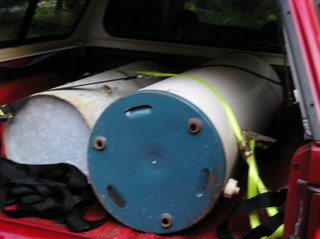 If you've not yet tried Freecycle, you need to... one small but powerful means of avoiding sending things to the landfill by asking your fellow humans if they would like some of your stuff, or asking if any of them have a particular stuff you need. It's great stuff. So far, Freecycle Columbus has enabled me to give away a chain saw, bike and scooter, as well as acquire 3 pallets, a 50-gallon water heater, a dryer and dishwasher (for pump and motor salvage), and a 40-gallon water tank. My latest acquisition today, the tank and heater, were a great find. Thanks to Donna and John (?) for this find, and for helping me lug it out of their basement. This easily saved me $50, kept it out of the landfill, and saved me from hours of welding.
If you've not yet tried Freecycle, you need to... one small but powerful means of avoiding sending things to the landfill by asking your fellow humans if they would like some of your stuff, or asking if any of them have a particular stuff you need. It's great stuff. So far, Freecycle Columbus has enabled me to give away a chain saw, bike and scooter, as well as acquire 3 pallets, a 50-gallon water heater, a dryer and dishwasher (for pump and motor salvage), and a 40-gallon water tank. My latest acquisition today, the tank and heater, were a great find. Thanks to Donna and John (?) for this find, and for helping me lug it out of their basement. This easily saved me $50, kept it out of the landfill, and saved me from hours of welding.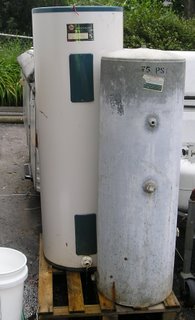 The 52 gallon water heater holds water without leaking, and should be a great addition to my processor. Once I got all sediment out of it (as you'll find in any old water heater), I filled it with bleach water to kill the bacteria, and drained it again, and now it's happily drying in my driveway. I'm not sure exactly how I'll use the water tank, but it looks very solid, and has 4 large and 2 small ports, so there are a variety of thing I should be able to use it for. However, a stand pipe would be impossible without drilling and welding, as none of the holes are top or bottom mounted. I may just use it as a water tank so I won't have to continually walk around to the other side of the house to turn on/off the spigot. :-) Ah well, I'm sure I'll think of something.
The 52 gallon water heater holds water without leaking, and should be a great addition to my processor. Once I got all sediment out of it (as you'll find in any old water heater), I filled it with bleach water to kill the bacteria, and drained it again, and now it's happily drying in my driveway. I'm not sure exactly how I'll use the water tank, but it looks very solid, and has 4 large and 2 small ports, so there are a variety of thing I should be able to use it for. However, a stand pipe would be impossible without drilling and welding, as none of the holes are top or bottom mounted. I may just use it as a water tank so I won't have to continually walk around to the other side of the house to turn on/off the spigot. :-) Ah well, I'm sure I'll think of something.Incidentally, I'm REALLY glad I didn't pick them up with the minivan last night, as they leaked all over the back of the truck. No problem in a pickup truck, but it's a lot harder to hose out a carpteted minivan.
Tuesday, June 6
Great free tank
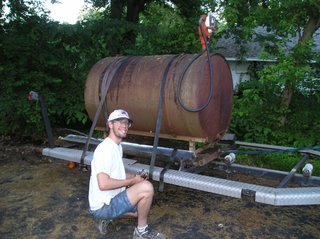
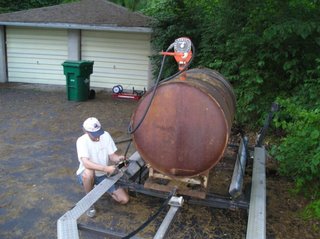
Thanks to Freecycle, I was able to score a free 350-gallon tank with hand pump and meter from a local source. This was free as in "free beer" not OpenSource "freedom to innovate"! Bio Joe (pictured) and I loaded it on his boat trailer, after some judicious hefting, winching, and a few loading methods definitely note approved by OSHA. But it worked, no one was injured, and nothing was broken, including laws. This will be a great tank for us to use for oil collection, or perhaps for holding processed biodiesel to dispense to members.
Monday, June 5
Testing the mist washer prototype
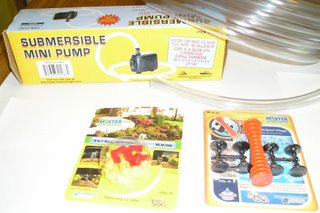
I purchased some misting components over the past few days, and finally assembled them today to see if it would mist well. The basic components are:
- Small submersible pump from Harbor Freight - $9
- 1/2" tubing from Harbor Freight - $4
- Misting plugs from Lowes (plumbing) - $3
- Mist plug insertion tool from Lowes (plumbing) - $3
All I basically had to do for assembly was to use the insertion tool to make holes in the tubing, then push the plugs in until they were barely into the hole, then twist them in so that the threads would help hold them in. For the prototype, I created a tube coming 3' up from the pump, to simulate the height from the bottom to the top of a 55-gallon drum, then a 20" diameter loop, which will run around the perimeter of the drum head.
Emily, my daughter, is modeling the final assembly, though I couldn't get her to hold it while it was running. :-) It worked like a champ, with a fine mist.
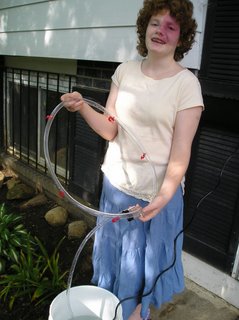
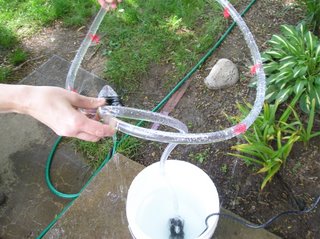
The benefit of this approach over the Arizona system hooked to a garden hose is:
- It's a closed loop system, so I can mist overnight, and not worry about having added too much water to my batch. With the garden hose system, you have to worry about how many gallons you're adding.
- As a closed loop system, I'm not pumping water through my main processor pump, so it helps keep water away from the H2O sensitive methanol reaction.
- The price was cheap.
Friday, June 2
Biodiesel Hillbilly
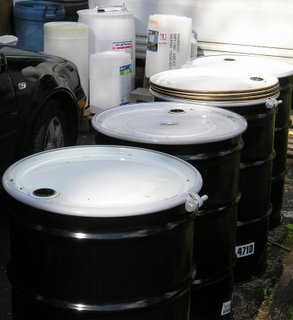
Yup, my driveway is starting to look like the biodiesel equivalent of redneck chique. Instead of basset hounds under the porch, cars on blocks, and 2 major appliances outside, it looks like a chemical supply house. I have 4 steel drums, 3 carboys, 2 HDPE drums, bung wrench, pipe, a couple of pallets... I'm wondering what the neighbors are starting to think.
Thursday, June 1
Free Drums & Carboys
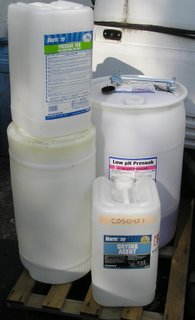
Kudos to Mark M. for the great tip on where to find free drums -- the local carwash can be a great resource. The coin-operated self wash doesn't have enough volume, and I've only once caught the manager at one, but the full-service car wash seems to be a great source for drums and carboys. I've picked up 4, and two attendents are keeping more for me. Great tip, Mark!
So, not only am I getting great size drums for washing and methanol, but I'm keeping them out of the landfill as well. Since they only contained soap before, they're pretty safe as greywater -- I've been putting a couple gallons of water in them, and then using it to wash my car, with great results. Heck, it is carwash soap after all, why not use it to wash my car?

